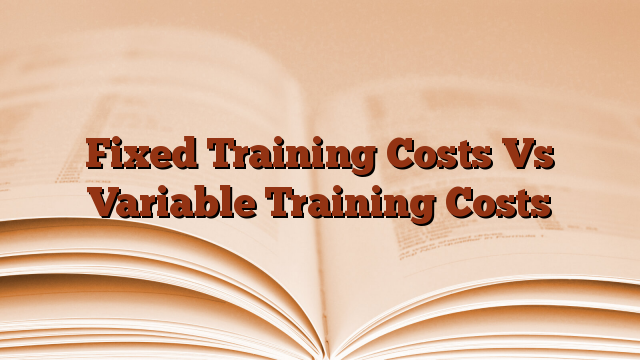Current economics makes it difficult for training departments to obtain additional funds, let alone normal operating funds. Often departments have to “make do” with the budget they’ve been given. But once you have a budget, no matter how big or small, you should have an idea of which costs are fixed and which are variable.
Fixed training costs are simply the ones you can count on at any time. You budget for these costs and rest assured that they will most likely stay the same. For example, the salaries of the training staff are relatively fixed. As you work on your budget, for whatever period of time, you’ll know if you can add staff, which we’ll discuss in a moment. You also know how much to budget for increases based on last year’s average. But overall, you can count on the salary as a fixed item.
The equipment you routinely use for training is also a fixed price. In fact, much of the equipment used by training departments is bought and paid for all at once. These items are everyday items such as copiers, computers, laptops, overhead projectors, LCDs, screens, automatic whiteboards, and any other equipment routinely used in the classroom or administrative office. But don’t forget that you must determine the cost of maintaining these items. Overhead and LCD bulbs are quite expensive and must be replaced with a manufacturer-approved item. One way to fix these costs is to know how long these items will last and plan for their replacement accordingly. One of the biggest shocks to a training budget is when all of the LCDs burn out at once, resulting in an expense that can add up to thousands of dollars.
Overheads are also fixed costs. As a trainer, you know how much it costs to maintain your site or sites. These costs include the rent or mortgage payment, expenses associated with the locations such as stationery and paper, and any income generated by leasing space in a building owned by other departments or companies. You can also include the utilities as a fixed cost, but be careful if the weather gets extremely hot or extremely cold – one way to do this is to have the tech install timed thermostats. Many organizations waste running costs heating and cooling rooms that sit vacant overnight or over a weekend, allowing the training department to continue to prove their worth by turning off utilities when not in use.
After all, fixed or planned programs are also fixed costs. For example, if you know how many people will be in leadership development over the budget period, you can budget for materials and outsourcing costs right away. It is best to stick to planned programs unless changes are absolutely necessary.
On the other side of the budget, you need to plan variable costs more carefully. Do you pay usage fees for bandwidth or online courses based on the number of users? If so, is it a variable cost. You can look at the average usage from the previous year or simply purchase an extended number of users for online courses to manage those costs. But don’t end up in the position of turning people away.
Your material costs can also be variable. Think about what programs aren’t “pinned,” such as B. Training for new employees. You know the organization’s revenue, but can you expect big jumps in revenue? You also know the organization’s vision and business plan, so use those to plan your material costs. One of the best ways to deal with these costs is to buy materials as you need them and plan along the way. There’s nothing worse than ending up with boxes of outdated manuals.
Finally, large variable costs can include mergers, acquisitions, expansions and reductions. You should have an idea of where the organization is headed in terms of mergers or acquisitions – and budget accordingly. But there might be unexpected changes such as downsizing or expansions that result in you having to spend money on space remodeling or additional staff.
Managing variable items depends in large part on the type of budgeting system your organization uses. When budgets are set, there isn’t much wiggle room. But when budgets are “ongoing” budgets or “pro forma” budgets, you can manage your money a little more easily since variable costs fluctuate from side to side. With fixed budgets, the best way to deal with variable expenses is to look for ways to pay for them from fixed costs. When variables come your way, find out how the organization’s budget is being managed and ask finance managers for help.
Now that you know which training costs are fixed and which are variable, you’ll be better prepared to manage the money if problems arise.
Thanks to Bryant Nielson | #Fixed #Training #Costs #Variable #Training #Costs

Leave a Reply